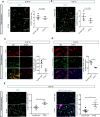Inhibition of Notch4 Using Novel Neutralizing Antibodies Reduces Tumor Growth in Murine Cancer Models by Targeting the Tumor Endothelium
- PMID: 38984877
- PMCID: PMC11289863
- DOI: 10.1158/2767-9764.CRC-24-0081
Inhibition of Notch4 Using Novel Neutralizing Antibodies Reduces Tumor Growth in Murine Cancer Models by Targeting the Tumor Endothelium
Abstract
Endothelial Notch signaling is critical for tumor angiogenesis. Notch1 blockade can interfere with tumor vessel function but causes tissue hypoxia and gastrointestinal toxicity. Notch4 is primarily expressed in endothelial cells, where it may promote angiogenesis; however, effective therapeutic targeting of Notch4 has not been successful. We developed highly specific Notch4-blocking antibodies, 6-3-A6 and humanized E7011, allowing therapeutic targeting of Notch4 to be assessed in tumor models. Notch4 was expressed in tumor endothelial cells in multiple cancer models, and endothelial expression was associated with response to E7011/6-3-A6. Anti-Notch4 treatment significantly delayed tumor growth in mouse models of breast, skin, and lung cancers. Enhanced tumor inhibition occurred when anti-Notch4 treatment was used in combination with chemotherapeutics. Endothelial transcriptomic analysis of murine breast tumors treated with 6-3-A6 identified significant changes in pathways of vascular function but caused only modest change in canonical Notch signaling. Analysis of early and late treatment timepoints revealed significant differences in vessel area and perfusion in response to anti-Notch4 treatment. We conclude that targeting Notch4 improves tumor growth control through endothelial intrinsic mechanisms.
Significance: A first-in-class anti-Notch4 agent, E7011, demonstrates strong antitumor effects in murine tumor models including breast carcinoma. Endothelial Notch4 blockade reduces perfusion and vessel area.
©2024 The Authors; Published by the American Association for Cancer Research.
Conflict of interest statement
Y. Kato reports a patent to US9969812B2 issued. Y. Adachi reports personal fees from Eisai Co., Ltd. during the conduct of the study, as well as a patent to US9969812B2 issued. Y. Sakamoto reports a patent to US9969812B2 issued. Y. Nakazawa reports personal fees from Eisai Co., Ltd. during the conduct of the study, as well as a patent to US9969812B2 issued. S. Tachino reports a patent to US9969812B2 issued. K. Ito reports a patent to US9969812B2 issued. T. Abe reports a patent to US9969812B2 issued. H. Ogasawara reports a patent to US9969812B2 issued. Y. Ozawa reports a patent to US9969812B2 issued. T. Imai reports grants and personal fees from Eisai Co., Ltd. outside the submitted work. Y. Funahashi reports personal fees from Eisai Co., Ltd. during the conduct of the study. J. Matsui reports a patent to US9527921B2 licensed. J. Kitajewski reports grants from Eisai Co., Ltd. during the conduct of the study, as well as a patent, US9969812B2, issued to Eisai Co., Ltd. related to this work. No other disclosures were reported.
Figures






References
-
- Bolós V, Grego-Bessa J, de la Pompa JL. Notch signaling in development and cancer. Endocr Rev 2007;28:339–63. - PubMed
-
- Uyttendaele H, Marazzi G, Wu G, Yan Q, Sassoon D, Kitajewski J. Notch4/int-3, a mammary proto-oncogene, is an endothelial cell-specific mammalian Notch gene. Development 1996;122:2251–9. - PubMed
Publication types
MeSH terms
Substances
Grants and funding
LinkOut - more resources
Full Text Sources
Molecular Biology Databases

